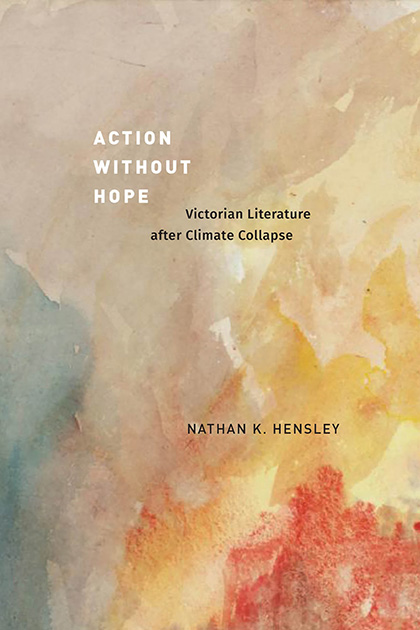Critical Inquiry Critical Inquiry
Nathan K. Hensley. Action without Hope: Victorian Literature after Climate Collapse. Chicago: University of Chicago Press, 2025. 344 pp.
Review by Karen Pinkus
7 July 2025
It has been twenty-five years since I began to ask: Is it still possible to study literature in the time of climate change? Is it ethical to escape, in literature, the fear and grief and anger of living in a world coming undone (a sense already felt in nineteenth-century Britain)? And, while reading, teaching, lecturing, and engaging with institutions both academic and non- on the topic of literature and climate change, I have lost count of how many times I have heard that no matter what, one must end on a note of hope. Sometimes that note is awkwardly tacked on to, say, an academic statement of purpose. Sometimes it comes through recourse to speculative futurity, nonhuman life forms, or indigenous practices. But mostly calls for hope and action, even when tied to anticapitalist or antiextractivist virtuosity, resonate as downright bad faith.
I have finally found a critical holy grail in Nathan Hensley’s stunning Action Without Hope. Through close readings of Emily Brontë, George Eliot, and others, the book challenges its readers to immerse themselves in the “fossil-fueled lifeworld” of the nineteenth century (p. 1). But just as we might acclimate to one line in a late poem by Christina Rossetti, Hensley wrenches us back into the futility of present “solutionist” rhetorics of individual actions aimed at “‘beating’ mass extinction” (p. 237). While extremely generous in its engagement with theorists and critics of all stripes, the meat of this book is Hensley’s relentless pursuit of the ground zero of the texts themselves. Not unlike Edward Said, Hensley searches the margins, in this case to recover the hidden violence of extractivist practices. He zooms in on punctuation marks or brushstrokes (J. M. W. Turner is a key figure in the book’s introduction), and then back out to think about mitigation, adaptation, and policies. The prestigious academic field of Victorian studies that informs this book, we are reminded, expanded precisely during the mid-twentieth century period of the Great Acceleration or, for some, the official golden spike of the Anthropocene era. Scale is a key term, as in the best work in environmental humanities. In Alfred Tennyson’s “Maud,” for instance, Hensley finds that “collapse organizes the poem at both the microscale of metrical scheme and the mesoscale of its structural organization.” (p. 69).
These shifts in focus and time constitute a discomforting method, one that may ultimately work best with the Victorian period, which “lives on in the material infrastructures and chemical aftereffects” of our warming present (p. 26). But one need not be an expert on this period (I am not) to be intoxicated by this book. Hensley’s method may not be as easily applicable to all literary-historical contexts but that is to take nothing away from the book’s powerful takedown of techno-optimism, or from the reminder that no matter what field one studies or in spite of the best intentions of researchers, universities “function most of all to ensure the smooth operation of the very extractionist paradigm whose consequences they purport to relieve” (p. 242). Ultimately, the book considers details (could we say, with Naomi Schor, of a feminine nature or from a feminine perspective?) of past practices that we should neither blame (“imperialist fossil capitalist extractivism started it all”) nor praise. Ultimately, we might locate in details an “archive of prior acts,” or “a repertoire of concrete possibility based on collective work” (p. 27). And that is a note of hope of the most modest and intellectually honest sort.

